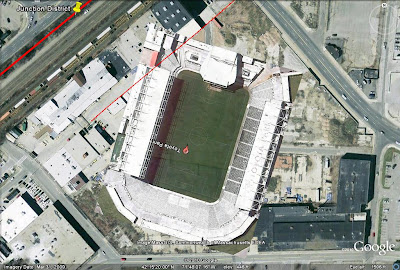 |
| 20,000 Seat Toyota Park (Home of the Chicago Fire) Superimposed on the Wyman-Gordon Site |
 |
| Wyman-Gordon Field in Relation to the Proposed Junction District Stop on the AIRLINE and Kelley Square/Canal District |
Meanwhile, it's known that the Kraft's, owners of the New England Revolution, a soccer club member of Major League Soccer (MLS), are looking to build a soccer specific stadium to house their team. Apparently they would like an urban location (check) with good access to public transportation (check - new Junction District stop is 1st stop on line from Union Station - a mere 45 min. express train ride from Boston). So far they have been focusing on an area known as Brickbottom in Somerville, and I certainly don't blame them for focusing their efforts on the Boston area. But I think there are some merits to considering the W-G site in Worcester:
- The current home of the Revolution is already outside of Boston - Moving from Foxboro to Worcester would likely be seen as a lateral move by Boston area residents - instead of driving/taking the T to Foxboro, they just drive or take the T to Worcester. South shore residents would have to trek further but Western MA, Hartford, CT area and VT and NH residents would all be closer. This would be much more challenging if the Revolution were already in Boston and we wanted to move them out of the city.
- 6 MM people in a 50 mi. radius - Soccer plays something like 16 home games plus playoffs a year. With relatively few games, the idea of taking an hour or two ride to get to the game is not so imposing as for baseball, hockey or basketball where there are a lot more games and thus you need a large local population to draw from. This is the New England Revolution after all, why not put them in the center of New England?
- A stadium of 20-25,000 seats could be supported in Worcester - If we were talking 60,000 seats it would not work, it's simply too big for Worcester. But a stadium in the low 20's seems like something Worcester could support. Other uses for the stadium include a new home field for Holy Cross football, summer concerts (Worcester has a strong concert scene and an outdoor venue like this does not exist in Central MA as far as I know. It seems to me that being able to offer this outdoor venue together with the DCU Center would be a great competitive advantage when looking to bring bigger acts to Worcester) and special events (graduations, World Cup soccer qualifying matches, international soccer exhibitions, and special events such as college lacrosse, field hockey and football games - maybe even a New Years Day outdoor hockey game featuring Holy Cross and a local rival?)
- A multicultural sport for a multicultural city - Worcester is a diverse city and must remain so if it is going to continue to grow in the years to come. What better way to promote diversity then by hosting an MLS team?
- MA Youth Soccer's fields are located in Lancaster, MA - MLS heavily promotes and support youth soccer in states/cities with teams and a number of teams have recently built youth facilities as part of their new facilities. Here in MA, MA Youth Soccer opened a world class facility in Lancaster, MA in 2007. The facility, with 11 natural grass and 5 synthetic turf fields on 130 acres is just 22 miles (less than a 30 minute drive along 190) as compared to 35 miles (approximately 1 hour assuming no traffic) to Somerville. If the Revolution want to build their relationship with MA Youth Soccer, they would do better choosing a Worcester location.
- Opportunities for spin off development - Like Patriot Place in Foxboro, there could easily be opportunities to develop retail opportunities in the vacant land connecting the proposed stadium to Kelley Square. Ideally the Blackstone would be day lighted in this area (I hear the Kraft's did a similar day lighting operation in Foxboro?) providing a unique destination for shopping and dining that you could only experience in Worcester. Perhaps focusing on the entertainment idea may be a good focus, maybe a Kings Bowling Center (with a special Worcester only Candlepin Room?). We could have developers such as thee Cordish Co. out of Baltimore (Power Plant Live! in Baltimore and similar projects in numerous other cities) take a look and see what they can come up with. I think the ideal mix would be to have more of a corporate feel in and around the stadium blending into a more regional/local flavor in the Canal District with smaller shops, etc.
- Soccer as a metaphor for Worcester's return to the national scene - Soccer, like Worcester, is known to most people in the US. Soccer, like Worcester, is not thought of as a top tier sport (mid-sized city) in the US. 25 years from now I think soccer will be thought of as a top tier sport and I believe, if Worcester continues to make smart decisions, it too will be thought of as a top tier mid-sized US city.



